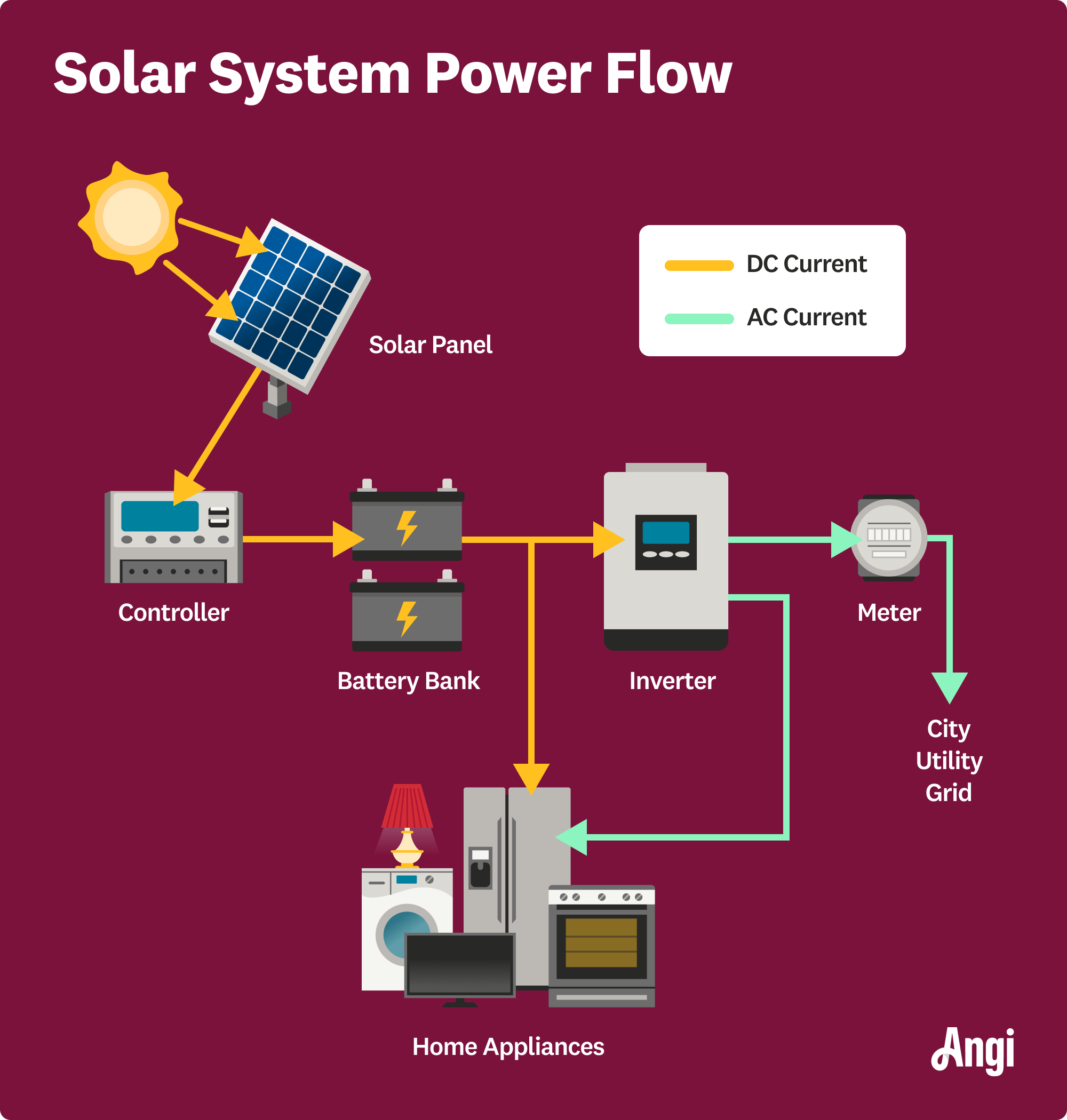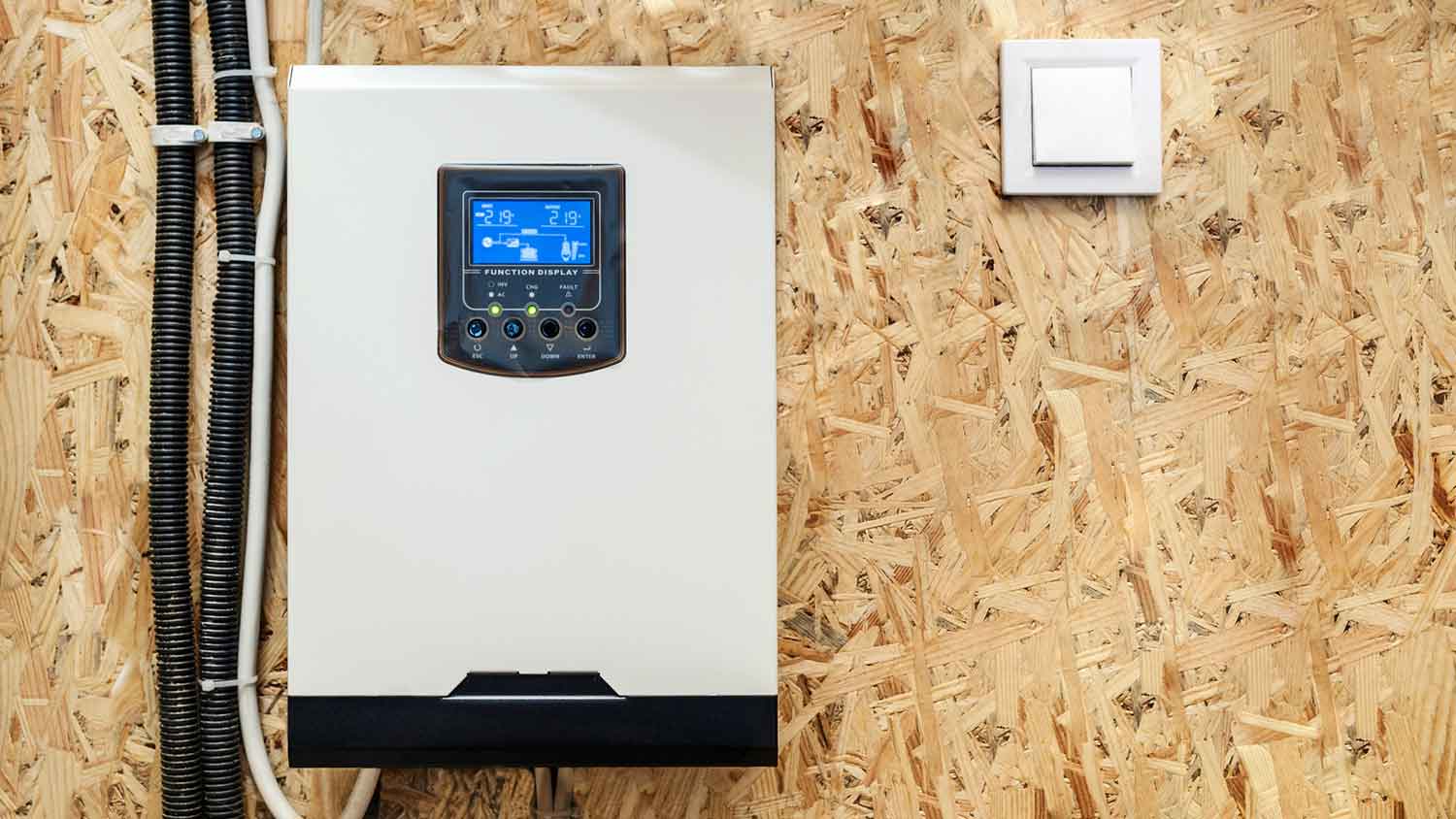
There are a few factors to consider when it comes to solar panel repair costs. This guide breaks down the prices of solar panel removal, repair, and replacement.
Solar panels get all the buzz, but solar inverters deserve some of the spotlight


Solar inverters convert DC electricity into AC electricity to power devices in your home.
Most home systems use a string inverter, but some use hybrid or microinverters.
On average, inverters cost about $1,000 to $3,000.
Inverters last 10 to 25 years before you need to replace them.
Solar panels transform sunlight into energy, but you wouldn’t be able to use that energy in your home without the help of a solar inverter. This piece of equipment is an essential component in photovoltaic (PV) solar energy systems. But not all inverters are exactly the same. There’s a range of types, from large central inverters for commercial systems to the smaller types of inverters you’ll find at home. So, what is a solar inverter, and how does it work? This guide will help break down how solar powers your home.
A solar inverter, also known as a solar power inverter, converts the direct current (DC) electricity created in your solar panels into alternating current (AC) electricity that you can use in your home. It’s a simple function, but it is entirely necessary. Here’s why.
When the sun hits your solar panels, it’s absorbed by the solar cell. This creates DC electricity, which is typically a lower voltage and can only run in one direction. However, it’s not compatible with the appliances in your home. Instead, the solar inverter transforms the current into AC electricity (120/240 volt power), which is the type of electricity used in your home.

Though the purpose of a solar inverter is simple, the actual mechanics are pure science. It works like this:
It starts with a PV cell. Your solar panels work because they have photovoltaic cells. These cells contain layers of a semiconductor material (typically crystalline silicon) that carry either a positive or negative charge. The layers are connected by a junction.
The sun hits the cell. When the sun hits your solar panels, it’s absorbed by the cell. The energy bounces between the negatively and positively charged layers, creating an electromagnetic field.
Your cell creates DC electricity. The electromagnetic field knocks electrons loose from the atoms in the PV cells. The electrons flow through the junction that connects the layers, creating a direct electrical current.
The current travels to the inverter. Your solar panels are wired into a solar inverter. The current flows from the cells to the inverter. It may make some stops along the way, like if you use a power optimizer (which optimizes energy output) or store your energy in a solar battery.
The inverter converts the power. There’s a transformer inside of your inverter that changes the voltage of the current. As the current hits the inverter’s transistors, the transistors shut off, which forces the current to change direction. This movement turns the direct current into an alternating current.
Most solar inverters last 10 to 25 years and carry a warranty that matches the average life span. You’ll likely need to replace your solar inverter before you need to replace your panels.

There are a few different types of solar inverters that you can use for a residential solar energy system.
This is the most common type of solar inverter. Several panels are wired into a single string inverter, which converts their collective energy.
Microinverters are generally used as a workaround for systems where panels may get uneven sunlight or are obstructed by shade. Each panel connects to its own microinverter, which converts the individual current. If some panels have reduced output, the rest of the panels aren’t dragged down.
Hybrid inverters are solar inverters that contain a backup battery and store excess power. These are often used for larger systems, off-grid systems, systems prone to power outages, and those that can utilize net-metering programs.
Power optimizers don’t convert currents—they regulate them. This device regulates the current to ensure each panel has optimum output before the electricity is sent to a string inverter. This prevents power loss and increases efficiency.
For most homeowners, solar inverters cost $1,000 to $3,000—though you could spend as much as $5,000 if you have a large system and use high-end inverters. String inverters cost $800 to $2,500, with an additional $50 to $200 per panel for power optimizers. Each microinverter will run you $150 to $350, and you’ll need one for each panel in your system. Hybrid inverters are the most expensive, running $1,000 to $5,000.
You’ll need a solar inverter close in wattage to the panels it needs to support. If you have a 6-kilowatt system, you should look for a 6,000-watt inverter. If you aren’t sure, you can use a solar panel inverter size calculator or speak with a local solar panel installer who can help you decide which inverter works best for your home.
Most homes use string inverters, especially when all of the panels receive even sunlight and face the equator (south if you’re in the Northern Hemisphere). Nonetheless, there are some instances where you may want to add power optimizers, choose microinverters, or spring for a hybrid inverter:
Some of your panels are obstructed by shade
Your panels face different directions
Your roof can’t support south-facing panels
You experience frequent power losses
You experience frequent cloudy or dusty weather
You want to participate in net metering
From average costs to expert advice, get all the answers you need to get your job done.

There are a few factors to consider when it comes to solar panel repair costs. This guide breaks down the prices of solar panel removal, repair, and replacement.

Discover the Tesla Powerwall installation cost, including average prices, cost factors, and tips to help homeowners budget and save on their Powerwall project.

Solar battery costs depend on the size of your system, labor, and capacity. Learn how much you could pay for batteries for home solar systems.

Most solar panel installations require a pro, but you can still learn how to install solar panels. Read this guide to install solar panels like a pro.

Avoid underpowered solar batteries and wasted money. From daily energy use to depth of discharge, this guide explains how to size a battery for solar panels.

Ready to make the switch and join the solar panel homeowner community? Here are 15 key questions to ask solar companies before you seal the deal.